
When I first learned of genius entrepreneur Nathan Myhrvold's endeavor to create THE Ultimate Work on Bread Baking, pouring thousands of dollars in his state-of-the-art scientific laboratory plus baking station, I was rather skeptical. After Modernist Cuisine now molecular baking?
But a presentation last summer at the Kneading Conference in Skowhegan/ME, with stunning photos of the process, was so convincing that I overcame my doubts (and qualms about spending so much money), and ordered my copy at Amazon.
The massive metal box set (History and Fundamentals, Ingredients, Techniques and Equipment, Recipes I and II, and a spiral bound kitchen manual with formulas) arrived in November, too heavy for one person to carry. Totally awed by those gorgeous, atlas-sized tomes, I asked myself the obvious question:
"Am I good enough for this Rolls Royce of baking books?"
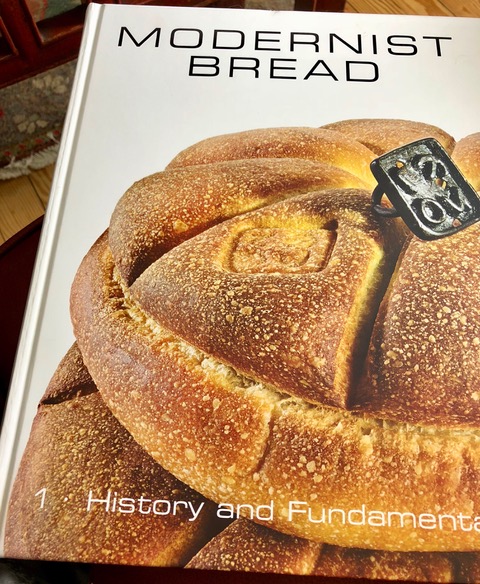
Being the anal Virgo, instead of undisciplined rushing at the recipes, I started reading the first volume, History and Fundamentals. Though I'm generally not a great fan of non-fiction, remembering with a shudder the all-night-cramming before my final medical exams, I found the book a very pleasant read, interesting, full of fascinating facts, and beautifully illustrated.
My husband, a Vietnam veteran, travels to Asia every year, Singapore, Cambodia, and, always, Vietnam. Whether in Saigon or Danang, his favorite food are Banh Mi sandwiches, and he misses them here in Maine.
The toppings, meat, pickles, cucumbers, chili and cilantro, are not hard to come by, but the Banh Mi breads are a totally different matter. Though French baguettes are their ancestors, Banh Mi rolls are different, with a thinner crust and softer, fluffier crumb.
With Richard just back from Saigon, I decided on Banh Mi rolls, my first loaves to bake from Modernist Bread.
I had tried to make them before, using the only recipe (from Andrea Nguyen) that appears to be circulating in the internet. It wasn't bad, but, according to my husband (and my own memory from my trip to Vietnam years ago), it wasn't right, either, no crackly crust, and too chewy.
For many of Myhrvold's breads you can choose between two or (even three) different formulas, a classic version, a "best" version, and a "modernist" approach (with unusual enhancements, like gelatin).
But for Banh Mi, there is only one recipe.
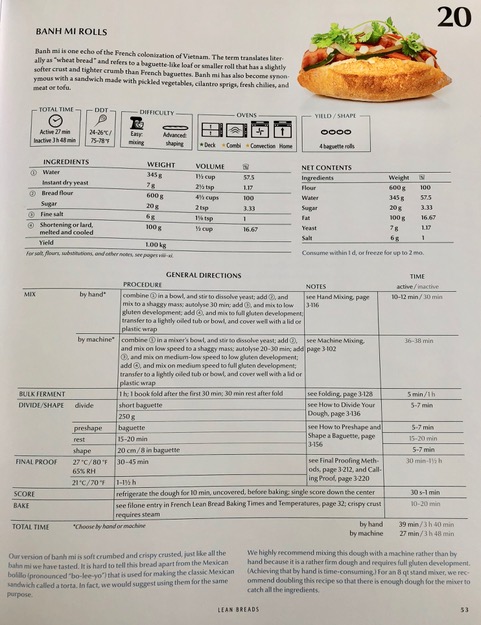
Though I often tweak formulas according to my own preferences, this time I didn't not stray from the Modernist's path, awed by the expertise of the authors. I wondered a bit about the shortening (or lard) in the bread - no fat in French baguettes, and why would bakers in a poor Asian country add a costly enrichment to their dough?
Instead repeating the mixing procedures and different steps for shaping, and proofing in every formula, Modernist Bread refers to detailed instructions in volume 3 (Techniques and Equipment). Fine.
But would it have killed them (or taken up too much space) to put oven temperatures and baking times into the recipes? You had to look under "filone entry in French Lean Bread Baking Times and Temperatures", several pages back, to find them - or not, since there was no filone in the list!
And why is cold bulk fermentation only very briefly and cursorily mentioned as an option? Instead, the Techniques section offered retardation of the shaped breads, along with fermentation at different room temperatures. Great, if you bake only one loaf - or have a walk-in refrigerator!
I started my mixing process, following the Modernist Bread's instructions - and was confronted with my first question: "add salt and mix on medium-low speed to low gluten development; add melted shortening or lard, and mix on medium speed to full gluten development."
How do I gauge low gluten development? I added the shortening after I mixed in the salt, drizzling it slowly into the mixer bowl. But, alas, my gluten development was faster, my dough did not welcome the greasy addition, resisting its incorporation, and, instead, swishing the liquid fat all around in the bowl.
It took a long time of mixing, until the dough looked somewhat homogeneous - but it was still coated in grease!
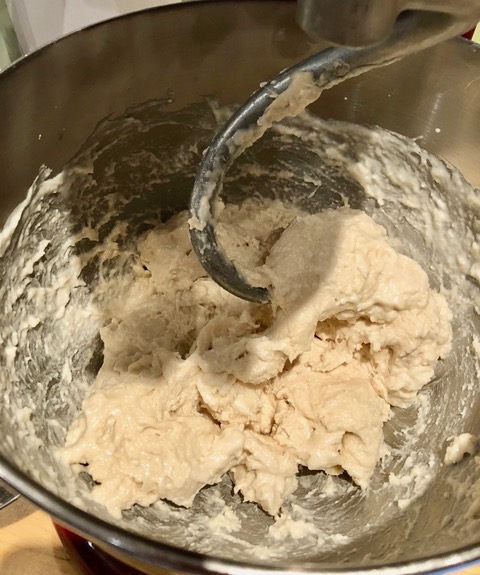
No help for that, I had to trust in the mitigating effect of long fermentation (I did the cold bulk), especially since my 7-qt Kitchen Aid, deciding, "enough is enough", switched itself off to avoid overheating.
Everything else, shaping and proofing, went according to plan, until it was time to bake.
Modernist Bread pooh-poohs every steaming measure we poor hobby bakers are able to employ, except for using a Dutch oven or a covered baker. Tough luck for home-based micro-bakeries like mine that need to process more than one loaf at a time!
I guess I have to live with my guilt of using my modest, pebble filled steam pan.
In the "French Lean Bread Baking Temperatures and Times" table I found only temperature for baking (470ºF/245ºC), not for preheating the oven. I remembered having come across it somewhere in the Technique volume, but couldn't find that paragraph again.
Assuming 500ºF would be okay, I preheated my oven (which keeps the correct temperature), with baking stone and steaming device in place. According to the time table, the small baguettes should be baked for 15 minutes with steam, and 10 minutes without, at 470ºF.
But when I checked after 15 minutes, to remove the steam pan, they were already fully baked, with an interior temperature of 211ºF.
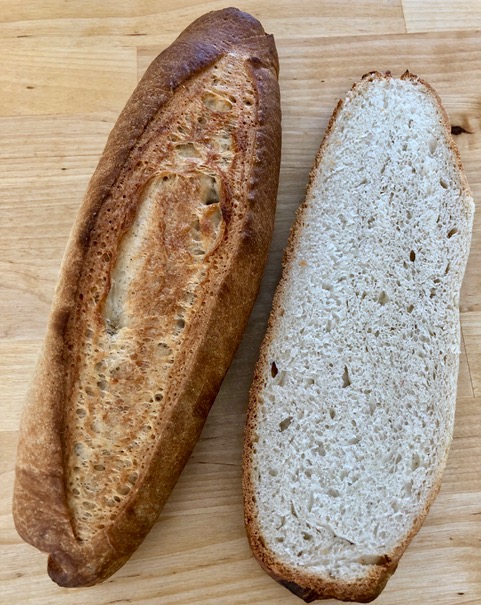
The baguettes looked okay from the outside, though the crust was not crackly. But when we cut the baguettes in halves to make sandwiches, we were in for a big disappointment. Instead of airy and fluffy, the crumb was dense and chewy.
And worse - they didn't taste like Banh Mi at all, more like brioche (made with shortening instead of butter). We ate our sandwiches, grumbling, and I was sorely tempted to throw the remaining two loaves in the trash - something I hardly ever do with my bread, even if it's burnt, or otherwise malfatti.
In the end the frugal housewife prevailed - I cut off the bread crusts and ground them into crumbs. And worked the loaves into a really nice bread pudding!
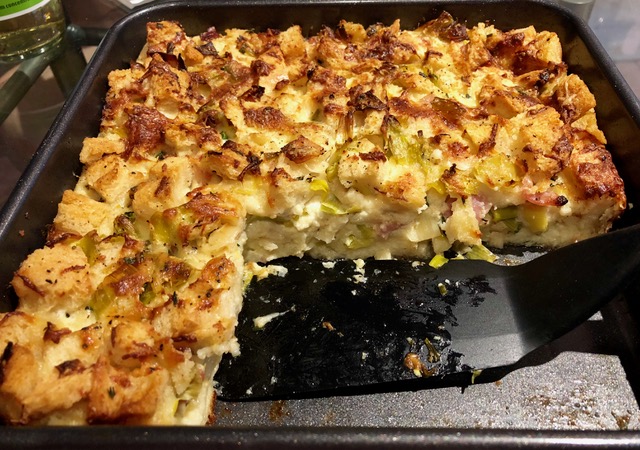
Successfully recycled - Leek Bread Pudding, made of Banh Mi rolls.
- hanseata's Blog
- Log in or register to post comments
had to a real Banh Mi, Saigon 1971-1973, was in Houston Texas made by a Vietnamese refugee Shrimper. He made some killer shrimp rolls as well. The 2nd closest was some bolillo rolls I got here in Gilbert, AZ from the hispanic market and put in the oven at 425 F for 5 minutes before using. The French too their n=bread with them from Mexico to Vietnam but the locals made it their own.
Butter was hard to find in Vietnam but pork at was everywhere - just like Mexico. Leaf lard is the key but not the way a Modernist would do it :-) Room temp leaf lard that is added after the dough has hydrated but little gluten development is the key. Just mix in the water with a spoon or mixer for a tiny amount of time and let it sit as a shaggy mass for 20 minutes, Then in goes the leaf lard and mix for a very short time say 2 minutes on speed 2 till it just incorporates, Then let it sit for and hour. Then follow your normal light handed way to make short baggies - bake at 425 F for 8 minutes with steam and then finish off with convection till the tolls hit 208F about 8 minutes more.
That should get you close Karin.
DB - and what about sugar? Do you see the formula above to be about right on that front?
To my uneducated western pallet, we have a pretty killer banh mi place in the nearest big city, and the rolls are pretty amazing...and nothing like my traditional poolish baguettes. Nonetheless, I use the latter in a soon to be annual banh mi fest at my place, where a dozen or two of these guys are still a touch warm when they get sliced up. It works well, but I'd like to work on something more authentic.
And given a number of vegetarians in the group...I wonder what the best alternative source of fat might be...
Sugar looks OK. I have a problem with the bread flour. The French use low protein flour for their baggies certainly not bread flour. I would think that grocery store bought Gold Medal or Pillsbury AP would be much better even at the same hydration.
In Germany you can buy lard in every supermarket and butcher's shop, often even goose fat. Here in Maine it's much harder to find.
I wonder whether there should be fat at all in the bread, or definitely not such a large amount: 16,67%. DMB, I will keep you good advice on how to add fat in mind, I had another bread where I encountered the same issue with the oil addition.
You are absolutely right about the flour, I don't think the Vietnamese import their wheat from Montana. With bread flour you will not get a fluffy crumb that you can easily pull out or compress to fit the lots of toppings in the sandwiches.
I will experiment with another recipe I found at YouTube, and see what my husband has to say. Hopefully, I will have better luck with that than with my unsuccessful attempts of making a cherry pie just like his mother :)
20-25 g 17% is ridiculous.
It makes the crumb really dense.
Modernist version seems odd because of so much lard in the recipe. I haven't tried to bake this kind of bread, but researched about it a while ago.
The first tip mentioned in this article said: Skip the fat:
"Don't add butter, shortening, or chicken fat (as I did) to the dough, or it will result in heavier, doughy bread. It weighs the dough down. In Vietnam, fat is a luxury. Why would they add it to bread? Duh."
The 2nd tip is to use "low-protein unbleached all-purpose flour".
Also check out this video:
Here is the video aboutlocal Banh mi production in Vietnam:
I saw those videos, too, and I will give it another try. I wonder, though, how the Modernist people could be so wrong, since they claim to come up with their „best“ version after studying all the recipes that are out there.
There are number of really critical discussions of these books, which not only point out questionable content (like you), but characterize the whole project as one that is overly ambitious, if not misguided and arrogant.
I will say, however, that putting together any book, let alone a collection like this, that is 100% spot on, is a pretty tall task. On the other hand, it seems that high expectations are appropriate, given the claims and attitude of the authors. Perhaps this is what they mean by "groundbreaking" and "revolutionary".
that I’ve read so far, I was quite satisfied. This was now the first recipe I tried, and I will see what happens with the next (and will report).
But you are really have high expectations when you purchase an opus with this fanfare and price.
Just in case anyone fancies a listen :)
https://www.bbc.co.uk/programmes/b09vz6r3
:)
Karin
Back to the banh mi project: curious that Andrea Nguyen, whose article is linked above, says in that piece to use low protein flour (and skip the fat), then in her book, apparently calls for adding vital wheat gluten (along with shortening, and ascorbic acid)...
https://food52.com/blog/11580-how-to-make-banh-mi-rolls-and-build-a-banh-mi-sandwich
Also, a bunch of TFL discussion here:
http://www.thefreshloaf.com/node/19301/banh-mi
I have Andrea’s book, and tried to bake from her recipe there, though I omitted the vital wheat gluten and the ascorbic acid. That bread, though tasting better than the Modernist one, was not right, either. She explained there that she was no baker, and had just tried to come up with a recipe that might work.
The article in Food52 was most likely published later.
Do you think banh mi's fluffy crumb is closer to German brotchen with just a more delicate crust? Perhaps you can try 00 flour just like in your brotchen recipe, omit the fat then use a serious amount of steam in the bake. Just my thoughts. By the way, I really want to try your brotchen recipe but I cannot find that special flour.
what I will do next. My husband said the crumb of the banh mi should be more like my German brötchen crumb. I have Italian 00 flour, and will use it, and see how that turns out.
Thanks, Karin, for this detailed review of the books. Not that I would be buying them anyway. I try not to buy books I can't lift. :)
I found somewhat the same issue with America's Test Kitchen book "Bread Illustrated". I find their supposedly well-tested recipes to be not anywhere near as good as, say, some of the stuff posted here on TFL.
Good luck with your banh mi search!
Wendy
You are right, these tomes are definitely nothing you care to carry around. Mine are sitting on a massive table in our hallway, where I managed to get them up, piece by piece!
I bought the “Bread Illustrated”, but haven’t tried anything from it, yet. I made several glutenf-free breads from America’s Test Kitchen’s GF baking books (out of curiousity, I have to problems with gluten) and those were really good.
Banh mi shops in Saigon never used soy sauce, it was always Maggi sauce...,
Wild-Yeast
of all good chefs, I tell my husband every time I “Bamm!” some Maggi into stews.
Yes, that’s what my husband said, too: Maggi, not soy sauce, is the popular condiment in banh mi. No wonder, since the French use it, too.
Karin
Hanseata,
The first video, Helen's Videos, is the more authentic recipe. She makes a sponge with AP flour, dried yeast, sugar and water. It's allowed to ferment for a couple of hours before the rest of the flour is added and the dough is processed. The other video ferments the sponge for 14-16 hours which indicates that this may be a hold over from the use of a natural levain (?). I believe this initial fermentation period may be key in deriving a higher taste effect in the finished banh mi. I don't think there's any use of fat nor rice flour in the standard banh mi - that's according to my Vietnamese friends in San Jose, they admitted that everyone's got their own secret recipe though the traditional rolls are considered the best tasting (which none of them could define by the way).
Banh mi is more of a way of serving a salad on bread roll (Vietnamese thinking) than as a sandwich (American thinking). I was thinking they would make a really mean "Sonora Dog" or "Street Dog" as they're know in LA but use the Vietnamese pickled vegetable condiments instead of the heavier ones used in street dogs. Okay, it's way off track but it is one of those fusion things that popped into my head and won't get out until I take a bash at it...,
Wild-Yeast
P.S. How about using them for crab rolls?
I'll definitely try Helen's recipe.
No, crab rolls have to be made with New England Frankfurter buns: the ones with cut sides, so that you can brown them in butter to make up for the little mayonnaise you use for the crab meat. We don't want to skimp on calories :)
Karin
Karin,
Julia Child's French bread recipe is contained in this Youtube video;
Flour - Salt - Water - Dried Yeast, Two rises to triple volume at 75dF. I seem to vaguely remember that the dough was let rise slowly during the night from prior time spent in Saigon...,
Crab rolls is likely too much of a Yankee tradition to break. Might work for a lightly smoked Dungeness crab sandwich served with a cold Anchor Steam beer though...,
Wild-Yeast
For some reason, I overlooked your post in my Emails. My inbox is mainly stuffed with charities and political parties asking for money, so it's easy to miss something.
I was looking about information about this cookbook and your post popped up. I hope that you have kept up you’re experimenting and figured out the way to make a wonderful roll
With way too many baking books and baking websites to look at, I only got to making the English Muffins (with poolish and levain). Those turned out really nice.
Although it is not one of my favorites the King Arthur website has a fast simple recipe for English Muffin Bread. The things we do for our husbands. I also call him my culinary muse. But we dont have the same palette. But when he loves a loaf I bake it.
but I haven't tried it, yet. Yes, I bake some things, too, because my husband likes them. Except for his beloved Cherry Pie, since he compared my first trials so brutally open with his mother's pies that I swore never to bake them it again :)